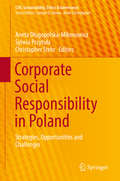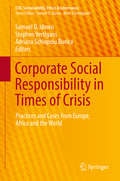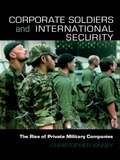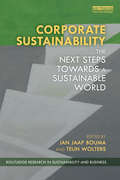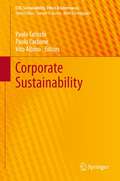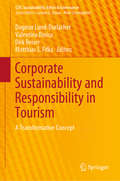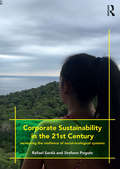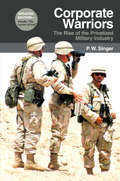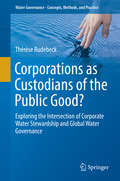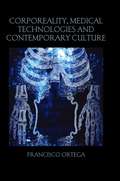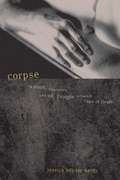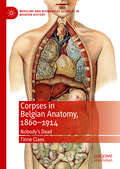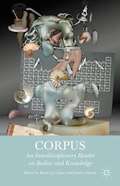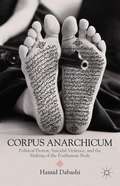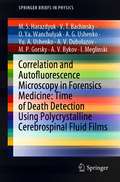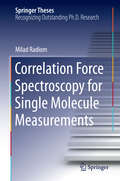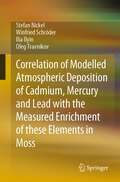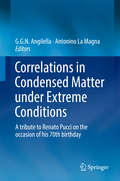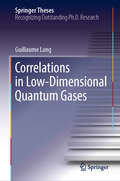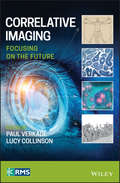- Table View
- List View
Corporate Social Responsibility in Poland: Strategies, Opportunities and Challenges (CSR, Sustainability, Ethics & Governance)
by Christopher Stehr Aneta Długopolska-Mikonowicz Sylwia PrzytułaThis book examines the development and adoption of corporate social responsibility (CSR) in Polish businesses and social and environmental organizations, and analyzes the corresponding impact at the strategic and operational level in these fields. It presents the status quo of CSR in Poland from three main perspectives: The first presents theoretical works based on current research and recent advances, while the next takes a closer look at empirical findings in the different fields of CSR (e.g. finance, reporting, law) and presents best practices from major international companies operating on the Polish market. Lastly, it presents a range of case studies from small and medium companies and NGOs in Poland and gives an outlook on the future development.Readers will benefit from an in-depth discussion of the opportunities and challenges that businesses and organizations in Poland are currently facing with regard to traditional national values and the influx of new cultural and social dimensions and patterns produced by international businesses entering the Polish market. Taken together, the lessons learned, case studies and snapshots of the latest developments provide a comprehensive overview of the state of the art of CSR in Poland, as well as a blueprint that can be applied to other Eastern European countries.
Corporate Social Responsibility in Times of Crisis: Practices and Cases from Europe, Africa and the World (CSR, Sustainability, Ethics & Governance)
by Samuel O. Idowu Stephen Vertigans Adriana Schiopoiu BurleaThis book explores national and transnational companies' Corporate Social Responsibility (CSR) activities in times and settings in which they are confronted with economic and social challenges and analyzes these situations, ranging from the financial crisis to fourth generation sustainability. Presenting a number of different cases from various parts of Europe, North America and Africa, it showcases how companies respond to the challenges of the development, consultation, implementation, integration, measurement and consolidation of CSR. Further it specifies how these corporations deal with uncertainties over corporate and financial resources, global financial stability and growing evidence for climate change. The book describes CSR adaptation under challenging circumstances and argues for the strategic and operative legitimation of Corporate Social Responsibility in times of crisis.
Corporate Soldiers and International Security: The Rise of Private Military Companies (Contemporary Security Studies)
by Christopher KinseyThis book traces the history of private military companies, with a special focus on UK private forces. Christopher Kinsey examines the mercenary companies that filled the ranks of many European armies right up to the 1850s, the organizations that operated in Africa in the 1960s and early 1970s, the rise of legally established private military companies in the late 1970s and early 1980s, and today’s private and important actors in international security and post-conflict reconstruction. He shows how and why the change from the mercenary organizations of the 1960s and 1970s came about, as the increasing newness of private military companies came to be recognised. It then examines how PMCs have been able to impact upon international security. Finally, Kinsey looks at the type of problems and advantages that can arise for organizations that decide to use private military companies and how they can make an unique contribution to international security. Corporate Soldiers and International Security will be of great interest to all students of international politics, security studies and war studies.
Corporate Sustainability: The Next Steps Towards a Sustainable World (Routledge Research in Sustainability and Business)
by Jan Jaap Bouma Teun WoltersThis book focuses on corporate sustainability and how it evolves through innovation and new business models. Despite what has been accomplished to date, there is an urgent need for further steps to be taken and this book presents a nuanced but compelling plea for collaboration between businesses, government and civil society. Drawing upon empirical research, the authors look at recent approaches to corporate sustainability, the circular economy and strategic corporate social responsibility. The book examines these issues from multiple viewpoints, including cultural, social and religious. More specifically, the book explores the freight sector (smart freight leadership), the banking sector (sustainable banking) and Islamic finance and sustainability, detailing the contribution of faith-based organizations to promoting sustainability and the greening of church buildings. Overall, this book captures the emerging new business models and capabilities firms need to implement sustainability. This book will be of great relevance to students, scholars and professionals with an interest in corporate sustainability, social responsibility, environmental management and eco-innovation.
Corporate Sustainability (CSR, Sustainability, Ethics & Governance)
by Paolo Taticchi Paolo Carbone Vito AlbinoSustainability is one of the key issues in today's society, as confirmed by the increasing attention of governments, media, academia and the industry. In the context of sustainable development, businesses that are often referred to as part of the problem can become part of the solution. This book presents the state of the art of sustainability in corporations from a number of perspectives, which include: economy, finance, measurement and reporting, organizing for sustainability, green products, green buildings and IT. The individual chapters provide valuable insights for pursuing future research and define a proper research agenda for the years to come. Further, the relevance of the topics addressed makes the book essential reading for academics, practitioners, consultants and more generally, for all those interested in business evolution and sustainability. The book was written by prominent researchers from Italy, India, the USA and the UK.
Corporate Sustainability and Responsibility in Tourism: A Transformative Concept (CSR, Sustainability, Ethics & Governance)
by Matthias S. Fifka Dagmar Lund-Durlacher Dirk Reiser Valentina DinicaThis book offers essential insights into how the world's second largest industry, tourism, is responding to challenges involved in expanding the corporate social responsibility (CSR) concept to corporate sustainability and responsibility, referred to as CSR 2.0. It analyzes the typical setup of tourism with various types of commercial agents: corporations, small and medium sized enterprises, public-private partnerships, social enterprises and local cooperatives. In addition, the book examines a broad range of voluntary initiatives, the effectiveness of these efforts, and how contextual and wider policy features shape these relationships. The book is divided into three parts, the first of which elaborates on strategic drivers and rationales for CSR. In turn, the second part introduces readers to design approaches for CSR programs and envisaged impacts, while part three focuses on implementation, certification, reporting, and possible outcomes. Each part offers a mixture of theoretical perspectives, synthesis analyses and case studies. The respective chapters tackle a broad spectrum of tourism sub-sectors, e.g. the cruise industry, aviation, gastronomy, nature-based tourism, and urban destinations.
Corporate Sustainability in the 21st Century: Increasing the Resilience of Social-Ecological Systems
by Rafael Sardá Stefano PogutzCorporate sustainability needs a rethink. We have entered the human-influenced Anthropocene age, and we are witnessing accelerating changes in earth system processes. Businesses’ current initiatives, such as product innovation and pollution reduction, are not enough to combat the intensifying social-ecological challenges that face us. Corporate Sustainability in the 21st Century is an innovative new textbook which provides a fresh conceptual framework for understanding and engaging with sustainability, now and in the future – "Business In Nature." This book critically discusses key concepts and topics related to corporate sustainability, with a focus on corporate sustainability strategies and corporate value chains. Setting itself apart from existing books, it introduces ideas from global ecology and the natural sciences to provide readers with a new language for discussing business and sustainability. This book maintains an international perspective throughout, with a wealth of examples, case studies and discussion questions. It will be a valuable text for students of corporate sustainability; business, nature and society; and environmental studies, and will also be useful for managers seeking a new perspective on how being "green" can fit with business goals.
Corporate Warriors
by P. W. SingerSome have claimed that ?War is too important to be left to the generals,? but P. W. Singer asks ?What about the business executives? Breaking out of the guns-for-hire mold of traditional mercenaries, corporations now sell skills and services that until recently only state militaries possessed. Their products range from trained commando teams to strategic advice from generals. This new ?Privatized Military Industry? encompasses hundreds of companies, thousands of employees, and billions of dollars in revenue. Whether as proxies or suppliers, such firms have participated in wars in Africa, Asia, the Balkans, and Latin America. More recently, they have become a key element in U. S. military operations. Private corporations working for profit now sway the course of national and international conflict, but the consequences have been little explored. In this book, Singer provides the first account of the military services industry and its broader implications. Corporate Warriors includes a description of how the business works, as well as portraits of each of the basic types of companies: military providers that offer troops for tactical operations; military consultants that supply expert advice and training; and military support companies that sell logistics, intelligence, and engineering. The privatization of warfare allows startling new capabilities and efficiencies in the ways that war is carried out. At the same time, however, Singer finds that the entrance of the profit motive onto the battlefield raises a series of troubling questions'for democracy, for ethics, for management, for human rights, and for national security.
Corporations as Custodians of the Public Good?: Exploring the Intersection of Corporate Water Stewardship and Global Water Governance (Water Governance - Concepts, Methods, and Practice)
by Thérèse RudebeckThis book provides a comprehensive assessment of how local corporate water strategies influence global water governance objectives. In various geographies, companies spearhead a quest for more sustainable water management within and beyond their own operations. This book critically examines such strategies and provides an overarching analysis of the effects that mounting corporate involvement has had on the global water discourse. More specifically, it explains why companies from the food, beverage, textile, and mining sectors have started to incorporate water management objectives into their business strategies, how companies work in partnerships with other stakeholders to realize these objectives, and how these actions acquire wider political legitimacy. It presents insightful interview material from business leaders and other high-level stakeholders. Readers will gain the necessary knowledge to develop a critical view and respond appropriately.
Corporeality, Medical Technologies and Contemporary Culture: Corporeality, Medical Technologies And Contemporary Culture (Birkbeck Law Press)
by Francisco OrtegaThis book examines the confusions and contradictions that manifest in prevalent attitudes towards the body, as well as in related bodily practices. The body is simultaneously our reference for the certainties of nature and the locus of a desire for transformation and reinvention. The body is at the same time worshipped and despised; an object of desire and of design. Francisco Ortega analyses how the body has become both a screen for the projection of our ideas and imaginings about ourselves and conversely an object of suspicion, anxiety, and discomfort. Addressing practices of corporeal ascesis (such as bodybuilding and dietetics), medical technologies, and radical anatomical modifications, Ortega documents the ambiguous legacy of a western theoretical tradition that has always despised the body. Utilising a theoretical framework that is mainly informed by the phenomenology of the body, feminist theory, disability studies and the thought of Michel Foucault, Corporeality, Medical Technologies and Contemporary Culture address several ethical and psychological issues associated with the experience and perception of the body in our cultural landscape. Drawing on these diverse areas of philosophical and analytical work, this book will interest those researching Law, Medicine, and Sociology.
Corpse: Nature, Forensics, And The Struggle To Pinpoint Time Of Death
by Jessica Snyder SachsWhen detectives come upon a murder victim, there's one thing they want to know above all else: When did the victim die? The answer can narrow a group of suspects, make or break an alibi, even assign a name to an unidentified body. But outside the fictional world of murder mysteries, time-of-death determinations have remained infamously elusive, bedeviling criminal investigators throughout history. Armed with an array of high-tech devices and tests, the world's best forensic pathologists are doing their best to shift the balance, but as Jessica Snyder Sachs demonstrates so eloquently in Corpse, this is a case in which nature might just trump technology: Plants, chemicals, and insects found near the body are turning out to be the fiercest weapons in our crime-fighting arsenal. In this highly original book, Sachs accompanies an eccentric group of entomologists, anthropologists, biochemists, and botanists--a new kind of biological "Mod Squad"--on some of their grisliest, most intractable cases. She also takes us into the courtroom, where "post-O. J. " forensic science as a whole is coming under fire and the new multidisciplinary art of forensic ecology is struggling to establish its credibility. Corpse is the fascinating story of the 2000year search to pinpoint time of death. It is also the terrible and beautiful story of what happens to our bodies when we die.
Corpses in Belgian Anatomy, 1860–1914: Nobody’s Dead (Medicine and Biomedical Sciences in Modern History)
by Tinne ClaesThis book tells the story of the thousands of corpses that ended up in the hands of anatomists in the late nineteenth and early twentieth centuries. Composed as a travel story from the point of view of the cadaver, this study offers a full-blown cultural history of death and dissection, with insights that easily go beyond the history of anatomy and the specific case of Belgium. From acquisition to disposal, the trajectories of the corpse changed under the influence of social policies, ideological tensions, religious sensitivities, cultures of death and broader changes in the field of medical ethics. Anatomists increasingly had to reconcile their ways with the diverse meanings that the dead body held. To a certain extent, as this book argues, they started to treat the corpse as subject rather than object. Interweaving broad historical evolutions with detailed case studies, this book offers unique insights into a field dominated by Anglo-American perspectives, evaluating the similarities and differences within other European contexts.
Corpus
by Monica J. Casper Paisley CurrahCorpus begins with the argument that traditional disciplines are unable to fully apprehend the body and embodiment and that critical study of these topics urgently demands interdisciplinary approaches. The collection's 14 previously unpublished essays grapple with the place of bodies in a range of twenty-first century knowledge practices, including trauma, surveillance, aging, fat, food, feminist technoscience, death, disability, biopolitics, and race, among others. The book's projected audience includes teachers and scholars of bodies and embodiment, interdisciplinary scholars and practitioners, and scholars interested in the any of the substantive content covered in the book. The collection could be adopted in courses on the body at advanced undergraduate and graduate levels, including: cultural studies; queer, gender and sexuality studies; body and power; biopolitics; intersectional approaches to the body; anthropology of the body; sociology of the body; embodiment and space; digital bodies; anthropology of knowledge production; health, illness, and medicine studies; science, knowledge, and technology studies; and philosophy and social theory.
Corpus Anarchicum
by Hamid DabashiDabashi's newest book is a meditation on suicidal violence in the immediate context of its most recent political surge and a critical examination of the radical transformation of the human body, supported by close readings of cinematic and artistic evidence.
Correlation and Autofluorescence Microscopy in Forensics Medicine: Time of Death Detection Using Polycrystalline Cerebrospinal Fluid Films (SpringerBriefs in Physics)
by M.S. Harazdyuk V.T. Bachinsky O.Ya. Wanchulyak A. G. Ushenko A.V. Dubolazov M.P. Gorsky A.V. Bykov Yu. A. Ushenko I. MeglinskiThis book highlights the first systematic synthesis of various research approaches in forensic medical diagnosis of the morphological and polycrystalline structure of human biological tissues and biological fluids. One of the global challenges in such diagnosis is the assessment of actual time of death. The relevance and objectivity of such studies are given by the innovative use of complex multifunctional methods using lasers and Mueller-matrix polarimetry, which is presented in this book. As a result, within the framework of the statistical, correlation and fractal approaches, diagnostic relationships were established between the time parameters of the transformation of the topographic structure of polarization-inhomogeneous microscopic images of biological preparations and necrotic changes in the morphological structure of biological tissues of the deceased. On this foundation, new forensic medicine criteria have been developed for objective determination of time of death.
Correlation Force Spectroscopy for Single Molecule Measurements (Springer Theses)
by Milad RadiomThis thesis addresses the development of a new force spectroscopy tool, correlation force spectroscopy (CFS) for the measurement of the properties of very small volumes of material (molecular to µm3) at kHz-MHz frequency range. CFS measures the simultaneous thermal fluctuations of two closely-spaced atomic force microscopy (AFM) cantilevers. CFS then calculates the cross-correlation in the thermal fluctuations that gives the mechanical properties of the matter that spans the gap of the two cantilevers. The book also discusses development of CFS, its advantages over AFM, and its application in single molecule force spectroscopy and micro-rheology.
Correlation of Modelled Atmospheric Deposition of Cadmium, Mercury and Lead with the Measured Enrichment of these Elements in Moss
by Stefan Nickel Winfried Schröder Ilia Ilyin Oleg TravnikovThe book provides a unique analysis of current air pollution in Germany by correlating results from chemical transport modelling and accumulation monitoring by moss.Results of most recent modelling of atmospheric concentration and deposition of the metal elements Cd, Hg and Pb are compared with the results of technical measurements and bioindication with mosses. These modelling results with status 2020 have a higher spatial resolution of 0.1° x 0.1° than the modelling results valid up to then (50 km x 50 km). This leads to partly slightly higher correlations between the findings of the modelling and those of the moss monitoring. In this study, descriptive and correlation-statistical parameters are calculated, results and recommendations drawn described. A statistically adequately deepened analysis and evaluation of the highresolution modelling results requires additional methodological tools, which are outlined in summary. It is particularly important to link the exposure data from modelling, technical measurements and the findings from moss monitoring with information on the receptors, the ecosystem types. This is the only way to ensure that the results of the present project contribute to a more differentiated assessment of the impacts on ecosystems from atmospheric heavy metal deposition than has been the case to date, thus enabling a targeted further development of risk assessments for German
Correlations in Condensed Matter under Extreme Conditions: A tribute to Renato Pucci on the occasion of his 70th birthday
by Antonino La Magna G. G. AngilellaThis book addresses a wide range of topics relating to the properties and behavior of condensed matter under extreme conditions such as intense magnetic and electric fields, high pressures, heat and cold, and mechanical stresses. It is divided into four sections devoted to condensed matter theory, molecular chemistry, theoretical physics, and the philosophy and history of science. The main themes include electronic correlations in material systems under extreme pressure and temperature conditions, surface physics, the transport properties of low-dimensional electronic systems, applications of the density functional theory in molecular systems, and graphene. The book is the outcome of a workshop held at the University of Catania, Italy, in honor of Professor Renato Pucci on the occasion of his 70th birthday. It includes selected invited contributions from collaborators and co-authors of Professor Pucci during his long and successful career, as well as from other distinguished guest authors.
Correlations in Low-Dimensional Quantum Gases (Springer Theses)
by Guillaume LangThe book addresses several aspects of thermodynamics and correlations in the strongly-interacting regime of one-dimensional bosons, a topic at the forefront of current theoretical and experimental studies. Strongly correlated systems of one-dimensional bosons have a long history of theoretical study. Their experimental realisation in ultracold atom experiments is the subject of current research, which took off in the early 2000s. Yet these experiments raise new theoretical questions, just begging to be answered. Correlation functions are readily available for experimental measurements. In this book, they are tackled by means of sophisticated theoretical methods developed in condensed matter physics and mathematical physics, such as bosonization, the Bethe Ansatz and conformal field theory. Readers are introduced to these techniques, which are subsequently used to investigate many-body static and dynamical correlation functions.
Correlative Imaging: Focusing on the Future (RMS - Royal Microscopical Society)
by Paul Verkade Lucy CollinsonBrings a fresh point of view to the current state of correlative imaging and the future of the field This book provides contributions from international experts on correlative imaging, describing their vision of future developments in the field based on where it is today. Starting with a brief historical overview of how the field evolved, it presents the latest developments in microscopy that facilitate the correlative workflow. It also discusses the need for an ideal correlative probe, applications in proteomic and elemental analysis, interpretation methods, and how correlative imaging can incorporate force microscopy, soft x-ray tomography, and volume electron microscopy techniques. Work on placing individual molecules within cells is also featured. Correlative Imaging: Focusing on the Future offers in-depth chapters on: correlative imaging from an LM perspective; the importance of sample processing for correlative imaging; correlative light and volume EM; correlation with scanning probe microscopies; and integrated microscopy. It looks at: cryo-correlative microscopy; correlative cryo soft X-ray imaging; and array tomography. Hydrated-state correlative imaging in vacuo, correlating data from different imaging modalities, and big data in correlative imaging are also considered. Brings a fresh view to one of the hottest topics within the imaging community: the correlative imaging field Discusses current research and offers expert thoughts on the field’s future developments Presented by internationally-recognized editors and contributors with extensive experience in research and applications Of interest to scientists working in the fields of imaging, structural biology, cell biology, developmental biology, neurobiology, cancer biology, infection and immunity, biomaterials and biomedicine Part of the Wiley–Royal Microscopical Society series Correlative Imaging: Focusing on the Future will appeal to those working in the expanding field of the biosciences, correlative microscopy and related microscopic areas. It will also benefit graduate students working in microscopy, as well as anyone working in the microscopy imaging field in biomedical research.
The Correspondence of Charles Darwin
by Frederick Burkhardt James A. SecordOver 850 letters between Darwin and worldwide correspondents, as he gathered information on human origins and the expression of emotion.
The Correspondence of Charles Darwin: VOLUME 24
by Frederick Burkhardt James A. SecordThis volume is part of the definitive edition of letters written by and to Charles Darwin, the most celebrated naturalist of the nineteenth century. Notes and appendixes put these fascinating and wide-ranging letters in context, making the letters accessible to both scholars and general readers. Darwin depended on correspondence to collect data from all over the world, and to discuss his emerging ideas with scientific colleagues, many of whom he never met in person. The letters are published chronologically: volume 24 includes letters from 1876, the year in which Darwin published Cross and Self Fertilisation in the Vegetable Kingdom, and started writing Forms of Flowers. In 1876, Darwin's daughter-in-law, Amy, died shortly after giving birth to a son, Bernard Darwin, an event that devastated the family. The volume includes a supplement of 182 letters from earlier years, including a newly discovered collection of letters from William Darwin, Darwin's eldest son.
The Correspondence Of Charles Darwin: Volume 20 1872
by Frederick Burkhardt James A. Secord Janet Browne Samantha Evans Shelley Innes Francis Neary Alison M. Pearn Anne Secord Paul WhiteThis volume is part of the definitive edition of letters written by and to Charles Darwin, the most celebrated naturalist of the nineteenth century. Notes and appendixes put these fascinating and wide-ranging letters in context, making the letters accessible to both scholars and general readers. Darwin depended on correspondence to collect data from all over the world, and to discuss his emerging ideas with scientific colleagues, many of whom he never met in person. The letters are published chronologically: volume 20 includes letters from 1872, the year in which The expression of the emotions in man and animals was published, making ground-breaking use of photography. Also in this year, the sixth and final edition of On the origin of species was published, and Darwin resumed his work on carnivorous plants and plant movement, finding unexpected similarities between the plant and animal kingdoms.
The Correspondence of Charles Darwin: Volume 26, 1878 (The Correspondence of Charles Darwin)
by Charles Darwin Frederick Burkhardt James A. Secord The Editors of the Darwin Correspondence ProjectThis volume is part of the definitive edition of letters written by and to Charles Darwin, the most celebrated naturalist of the nineteenth century. Notes and appendixes put these fascinating and wide-ranging letters in context, making the letters accessible to both scholars and general readers. Darwin depended on correspondence to collect data from all over the world, and to discuss his emerging ideas with scientific colleagues, many of whom he never met in person. The letters are published chronologically: volume 26 includes letters from 1878, the year in which Darwin with his son Francis carried out experiments on plant movement and bloom on plants. Francis spent the summer at a botanical research institute in Germany; and father and son exchanged many detailed letters about his work. Meanwhile, Darwin tried to secure government support for attempts by one of his Irish correspondents to breed a blight-resistant potato.
The Correspondence of Charles Darwin 1877: VOLUME 25 (The Correspondence of Charles Darwin)
by Frederick Burkhardt James A. SecordThis volume is part of the definitive edition of letters written by and to Charles Darwin, the most celebrated naturalist of the nineteenth century. Notes and appendixes put these fascinating and wide-ranging letters in context, making the letters accessible to both scholars and general readers. Darwin depended on correspondence to collect data from all over the world, and to discuss his emerging ideas with scientific colleagues, many of whom he never met in person. The letters are published chronologically: volume 25 includes letters from 1877, the year in which Darwin published Forms of Flowers and with his son Francis carried out experiments on plant movement and bloom on plants. Darwin was awarded an honorary LL. D. by Cambridge University, and appeared in person to receive it. The volume contains a number of appendixes, including two on the albums of photograph sent to Darwin by his Dutch, German, and Austrian admirers.
